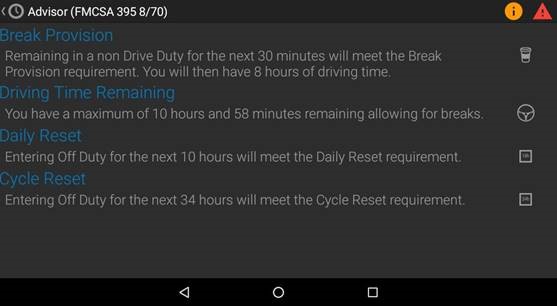
Hours of Service Rule Change: What Your Fleet Needs to Know
- Blog
- Transportation
- Hours of Service Rule Change: What Your Fleet Needs to Know
- Sep 14, 2020
- Denis Cody
 The FMCSA is introducing a change to HOS regulations to give drivers greater flexibility without impacting safety. The rule changes impact: the 30-minute break rule, split-sleeper berth provision, adverse driving condition exception, short-haul exception and comes into effect on September 29, 2020. The rule change comes after the agency reviewed the results of more than 8,000 public comments from industry stakeholders. “The reforms will improve safety on America’s roadways and strengthen the nation’s motor carrier industry,” said FMCSA Acting Administrator Jim Mullen.
The FMCSA is introducing a change to HOS regulations to give drivers greater flexibility without impacting safety. The rule changes impact: the 30-minute break rule, split-sleeper berth provision, adverse driving condition exception, short-haul exception and comes into effect on September 29, 2020. The rule change comes after the agency reviewed the results of more than 8,000 public comments from industry stakeholders. “The reforms will improve safety on America’s roadways and strengthen the nation’s motor carrier industry,” said FMCSA Acting Administrator Jim Mullen.
We spoke to ORBCOMM’s Scott Stofer, Director of Safety and Compliance, Fleet, who outlines the changes to come and how they will impact fleets and drivers in the real world.
What change will we see in the 30-Minute Break Requirement and how will it impact drivers and fleets?
There are a couple of changes coming into effect at midnight on September 28th. The 30-minute break rule has more options now. It can be taken with any status but driving.
The eight-hour timer is going to shift. It changes from starting when the driver comes on-duty for the day after a reset to starting the first time a driver starts driving for the day. The driver will be able to go on-duty, work in the yard, do training or admin work, but the clock that dictates the break, will not start until the wheels start turning for the day. The first time the driver goes into drive, the timer starts and within eight hours they will have to take their break.
There will also be some extra flexibility in the duty status that can be used during the break time. Previously, for a break, a driver had to use off-duty status. This change to the 30-minute break rule gives drivers more flexibility for their non-driving work. Now, for instance, if drivers are waiting at a location to pick up, the rule change will allow an on-duty not driving status to count towards a break.
What change will we see in the Adverse Driving Condition Rule and how will it impact drivers and fleets?
The change in the adverse driving condition rule gives drivers a lot more flexibility. The regulation will now give a full two hours of driving time regardless if they are at the end of the driving window or not. Previously, if a driver was up against their 14-hour driving window limit, they could only go as far as that 14-hour window would allow. With the new changes, it gives a full two hours, regardless of how much time is left on the 14-hour daily limit, as long as they qualify under adverse driving conditions rules.
The rule change normalizes the hours. The driver gets the two hours they might need. If they find themselves facing a qualified adverse driving situation, they can drive two hours to get to a safe haven, the yard, or wherever necessary under the circumstances. It will simplify management; it’ll simplify things for the driver.
What about the short-haul exception?
Drivers will have a bit more leeway with this rule update and better management of their hours. Essentially, two things are changing. Before, there was a 100-mile radius around the terminal. The driver stays within the hundred miles; no need to worry about Record of Duty Status (RODS). Now the FMCSA is expanding that out to 150 air miles. Each driver will get an extra 50 miles before they must maintain RODS.
The rule also provides for two extra hours of driving time. The previous rule stated that the truck had to return to the home terminal within 12 hours, now it’s extended to 14 hours.

How about the sleeper berth provision?
Previously, if the driver split the sleeper berth, it was two segments of at least eight and two hours to get a ten-hour break. They got the first segment of either eight or two, that pauses the 14-hour clock. The second segment, once complete, would give the driver their 10-hour break but the new 14-hour driving window would start at the end of the first segment.
Under the new regulation, the FMCSA has simplified it. They said we are not going to say one segment is going to count, while the other does not. From September 29, when the driver uses the sleeper berth and splits it, it will be between two periods; allowing a choice, for example, a split of eight and two hours, or seven and three hours, to make a total of 10 hours. Under the new regulation, the entire sleeper berth time will pause the clock. The 14-hour driving window restarts after the first break (as long as they get the full 10 hours) but now the driving clock pauses for both breaks. It’s easier to manage and the driver and carrier get a few hours back.
Are there any steps that fleets can take to make this easier on drivers?
There certainly is an educational aspect of it, especially for the short-haul, 30-min break and sleeper berth rules, to make drivers aware of the new updates. Let’s take the sleeper berth example. The drivers must understand the new limits and how it will impact them. They will be used to having that second period of two hours and the clock not stopping. It’s to their benefit, but there’s also a need to educate drivers that it’s coming so they can be prepared on the 29th.
For adverse driving conditions, companies will need to evaluate their procedures and decide how they want to activate it. The implementation is based on their method of operation. We are working with all our fleet customers on this now, in the lead-up to this change.
Is ORBCOMM ready for this update?
We have already been in development on this for some time. ORBCOMM is prepped and ready for the rollout of the new HOS rules. We will have all the changes in place, including the adverse driving conditions, which is a new option that we are introducing since the switch to ELD. The updates will happen automatically, apart from the adverse driving rule. For this, there will be an option within the system to configure adverse driving conditions if they so choose.
It will all be available at midnight on September 28. Anyone operating will pick up the change and move forward from the 29. We are working with our account management and sales team along with our customers to enable that, as per their policies and procedures.
Do you think there’ll be any further changes to the rules/regulations like this in the future?
I don’t think there’ll be any major changes like this for a while. This will need time to settle. If there is any further rule change down the line, ORBCOMM is fully committed. We are a committed ELD supplier and we’re already working on Canadian ELD. We’re here for the long haul.
The FCMA’s final rule includes the four key revisions to the existing HOS rules. These are:
- The sleeper berth provision allows drivers to split their 10-hour off-duty period in different ways (e.g., 7/3, 8/2, 7.5/2.5), provided one off-duty period (whether in or out of the sleeper berth) is at least 2 hours long, and the other involves at least 7 consecutive hours spent in the sleeper berth. The periods must add up to 10 hours, and when used together, neither time period counts against the maximum 14-hour driving window.
- The 30-minute break requirement can now be satisfied by an on-duty, not driving break (in addition to an off-duty break). The requirement for property-carrying drivers is applicable in situations where a driver has driven for a period of eight hours without at least a 30-minute interruption. A modification to the sleeper-berth exception to allow drivers to split the required 10 hours of duty into two periods. This can be an 8/2 split or a 7/3 split. Neither period will count against a driver’s 14-hour driving window.
- The adverse driving conditions exception is extending the duty day by two hours when adverse driving conditions are encountered. This is in addition to the extra two hours of driving time already allowed.
- This change applies for both property (14-hour driving window) and passenger (15-hour on-duty limit) motor carriers. The short-haul exception maximum allowable workday is changing from 12 to 14 hours, and the distance the driver may operate is extending from a 100 air-mile radius to a 150 air-mile radius.

As ORBCOMM’s Senior Director of Product Marketing, Denis Cody leverages over two decades of industry experience in international B2B marketing to help develop and execute GTM strategies, positioning and messaging for our suite of products and solutions.
















